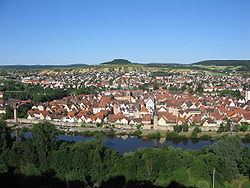Admin. region Unterfranken Elevation 163 m (535 ft) Area 98.11 km² Local time Friday 4:58 PM | Time zone CET/CEST (UTC+1/+2) Population 14,948 (31 Dec 2008) Postal code 97753 | |
 | ||
Weather 11°C, Wind NW at 10 km/h, 51% Humidity | ||
Karlstadt is a town in the Main-Spessart district in the Regierungsbezirk of Lower Franconia (Unterfranken) in Bavaria, Germany. It is the Main-Spessart district seat (Kreisstadt).
Contents
- Map of 97753 Karlstadt am Main Germany
- Location
- Constituent communities
- History
- Town council
- Coat of arms
- Transport
- Crafts and industry
- Winegrowing
- Education
- Notable people
- References
Map of 97753 Karlstadt am Main, Germany
The locals often call the town, in their own dialect, Karscht or Karscht am Mee (Karlstadt am Main). The townsfolk are called Flaak or Karschter Flaak.
Location
The town lies roughly 25 km north of Würzburg in the Main-Franconian winegrowing region.
Constituent communities
Since the amalgamations in 1978, Karlstadt’s Stadtteile are Gambach, Heßlar, Karlburg, Klein Laudenbach, Laudenbach, Mühlbach, Rohrbach, Stadelhofen, Stetten and Wiesenfeld.
History
From the late 6th to the mid 13th century, over on the other side of the Main, lay the unusually big valley settlement of Karlburg with its monastery and harbour. Its reason for being there was the Karlsburg, a castle perched high over the community that was destroyed only in the German Peasants' War in 1525. In 1202 came the founding of Karlstadt by Bishop Konrad von Querfurt. The exact founding date is unknown. However, given that the founder’s time in office was only four years, the time can be reckoned fairly easily.
The town was methodically laid out with a nearly rectangular plan to defend Würzburg territory against the Counts of Rieneck. The plan is still well preserved today. The streets in the Old Town are laid out much like a chessboard, but for military reasons they are not quite straight.
In 1225, Karlstadt had its first documentary mention. In 1236 the castle and the village of Karlburg were destroyed in the Rieneck Feud. In 1244, winegrowing in Karlstadt was mentioned for the first time. From 1277 comes the earliest evidence of the town seal. In 1304, the town fortifications were finished. The parish of Karlstadt was first named in 1339. In 1369 a hospital was founded. Between 1370 and 1515, radical remodelling work was being done on the first, Romanesque parish church to turn it into a Gothic hall church. About 1400, Karlstadt became for a short time the seat of an episcopal mint. The former Oberamt of the Princely Electorate (Hochstift) of Würzburg was, after Secularization, in Bavaria’s favour, passed in 1805 to Grand Duke Ferdinando III of Tuscany to form the Grand Duchy of Würzburg, and passed with this to Bavaria.
The town’s longtime Jewish inhabitants built themselves a synagogue at Hauptstraße 24, which was destroyed on Kristallnacht (9 November 1938) by SA men, an event recalled by a plaque at the synagogue’s former site.
Town council
The council is made up of 24 council members, not counting the mayor.
(as at municipal election held on 2 March 2008)
Coat of arms
The town’s arms might be described thus: Quarterly, first and fourth azure, second and third argent a fleur-de-lis gules.
The town’s earliest seal, from 1277, showed an effigy of Charlemagne, who is said to have founded and named the town (Charlemagne is called Karl der Große in German). The next seal after this one also bore Charlemagne’s likeness, and this appeared on town seals until the 18th century. However, in 1544, the town began using a quartered shield as its arms. This is thought to have come from the banner of state borne by the Prince-Bishopric (Hochstift) of Würzburg, to which the town once belonged. The fleurs-de-lis were added in the early 19th century, and they refer to Charlemagne.
Transport
Crafts and industry
The Düker Ironworks, the Schwenk Cement Works and the Kohl Wood Veneer Factory define the district seat’s south end. Besides these three great industrial plants, many handicraft businesses have also set up shop in Karlstadt. Another big employer is the Main-Spessart Landratsamt (District Council Head’s Office). There are moreover many inhabitants who commute to Würzburg, 25 km away, or Lohr am Main, 18 km away.
Winegrowing
Winegrowing has only slight economic importance nowadays but still has great cultural significance. Even if very few people in Karlstadt earn their livelihoods from winegrowing, it is still important for self-perception and the local way of life. Vineyards in Karlstadt are the Roßtal and Im Stein. There are also others in many of the outlying centres, especially in Stetten (Stettener Stein) and on the way from the main town out to Gambach.
Education
In 1999 the following institutions existed in Karlstadt:
